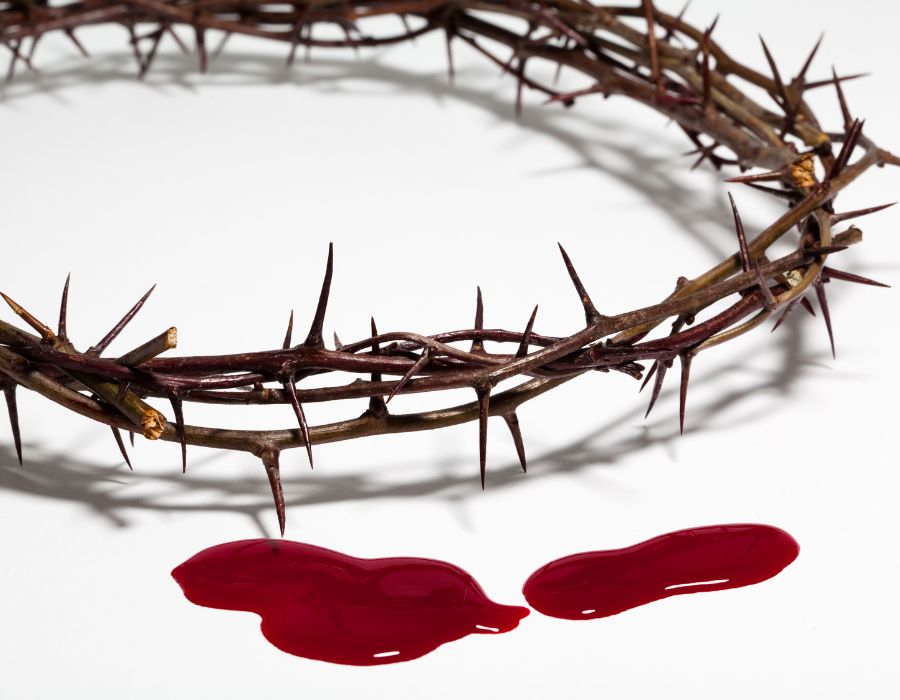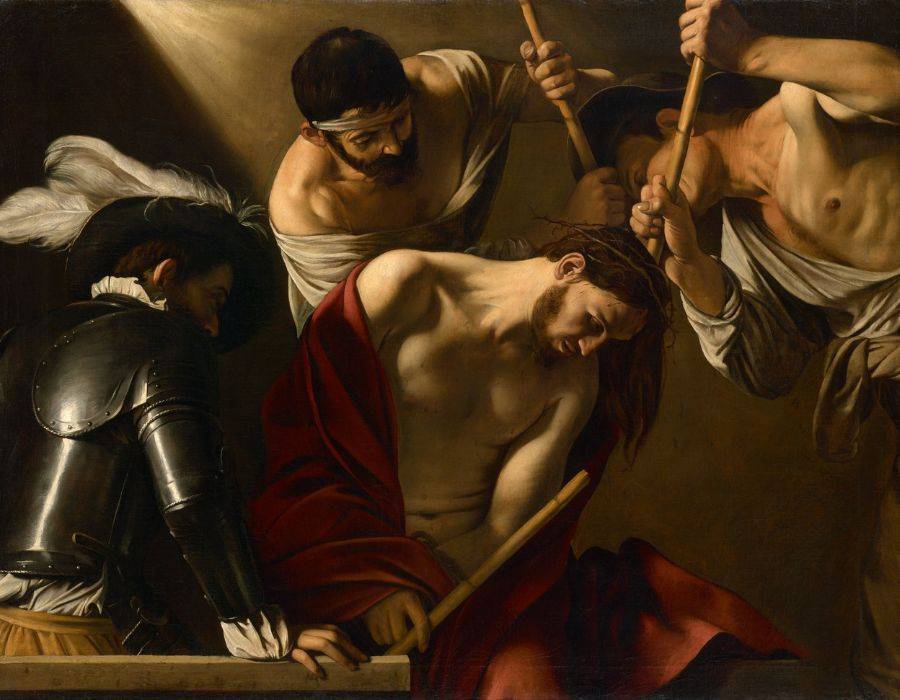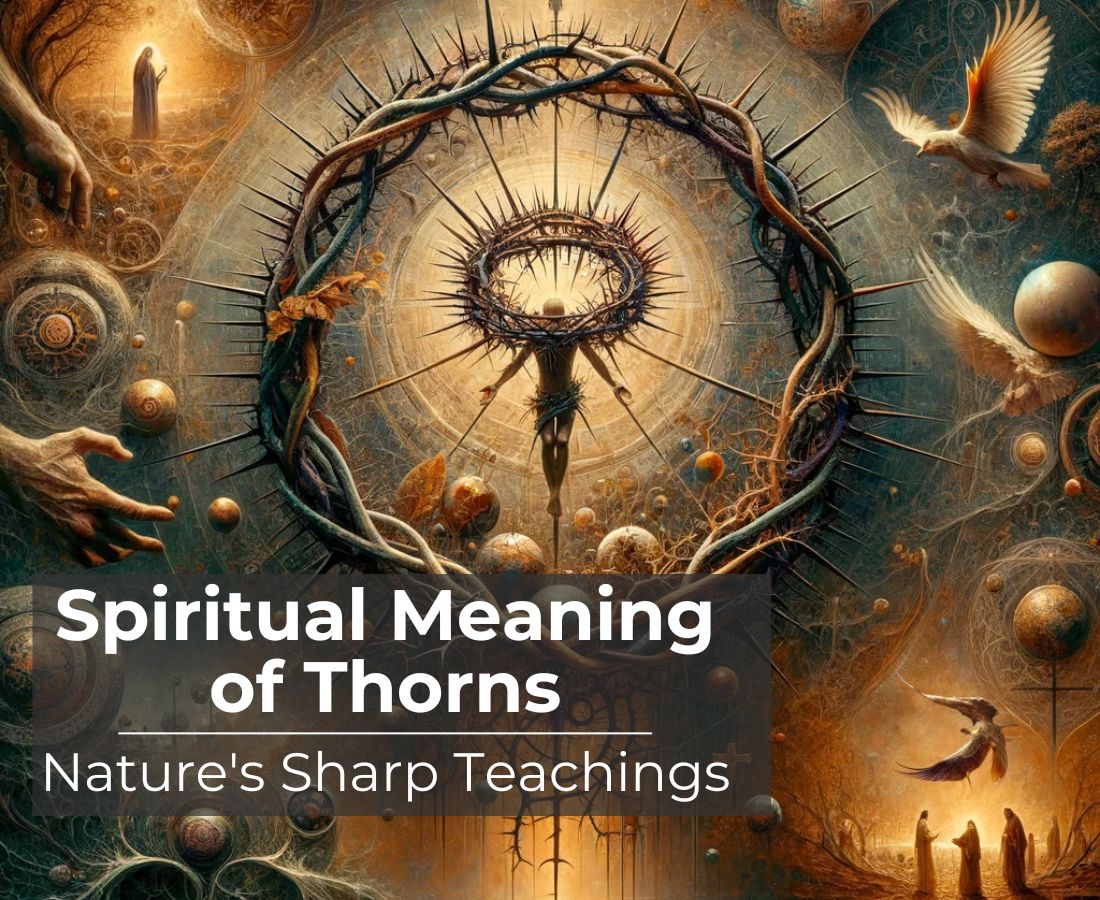This article peels back the layers of thorns’ meanings, from spiritual realms to literary pages. Stay with us as we unravel how a simple spine has pierced deep into cultural consciousness, offering insights that are as sharp in relevance as they are in form.
Table of Contents
Key Points
- Thorns symbolize boundaries, sacrifice, and spiritual guardianship.
- They hold profound meaning in Christianity and other religions.
- Thorns in art and literature reflect life’s dualities and complexities.
Exploring the Depths of Thorn Symbolism
Thorn symbolism is as rich and multifaceted as the history of humanity itself. These natural spikes have pierced through layers of culture, spirituality, and personal significance, each point a story, each story a reflection of life’s intricate dance.
The Protective Thorns of the Acacia Tree
The Acacia tree, crowned with a halo of thorns, stands as a sentinel across many African savannas. Its thorns serve as a natural fortress, safeguarding the delicate ecosystem within.
Spiritually, these thorns remind us of the need for boundaries to protect our personal growth and the sanctity of our inner gardens. In our lives, setting clear boundaries is as crucial as the Acacia’s thorns are to its survival.

A Symbol of Sacrifice
Perhaps no other image captures the spiritual essence of thorns as poignantly as the Crown of Thorns. Worn by Jesus during the crucifixion, it’s a powerful symbol of sacrifice and redemption.
This emblem teaches us that through suffering and self-sacrifice, we can achieve a greater purpose. In our daily struggles, the thorns we encounter can be transformative, leading to personal redemption.
Reflecting Life’s Complexities
From Shakespeare’s sonnets to modern poetry, thorns are a literary staple symbolizing the complexities of life. They represent the trials and tribulations that shape our character.
In the spiritual realm, these literary thorns challenge us to find meaning in our pain, urging us to grow and thrive amidst life’s prickly paths.
The Rose and Its Thorns: Love’s Duality
The rose, with its delicate petals and sharp thorns, embodies the duality of love — beauty and pain intertwined. Spiritually, the rose’s thorns represent the sacrifices and risks we take in the name of love.
They teach us that true love is not without its challenges, and it’s through overcoming these that love’s beauty is truly appreciated.
Thorns as Spiritual Guardians
In many cultures, thorns are seen as protectors against evil spirits and negative energies. They are the spiritual guardians that keep malevolence at bay.
In our lives, invoking the symbolism of thorns can be a powerful reminder to shield ourselves from negativity, to maintain our spiritual well-being amidst the chaos of the everyday.
The Spiritual Significance of Thorns Across History
| Thorn Symbol | Fact | Spiritual Lesson |
|---|---|---|
| Acacia Tree Thorns | Natural defense system in African savannas | The importance of setting boundaries for personal growth and protection |
| Crown of Thorns | Worn by Jesus during the crucifixion as a symbol of sacrifice | Suffering can lead to transformation and redemption |
| Thorns in Literature | Used to represent life’s challenges and complexities | Encourages finding meaning in pain and growing through adversity |
| Rose’s Thorns | Symbolize the risks and sacrifices in love | True love involves overcoming challenges and appreciating its beauty |
| Thorns as Guardians | Believed to ward off evil spirits and negative energy | Reminds us to protect our spiritual well-being from negative influences |
Thorns in Spirituality and Religion
Thorns appear throughout history, representing deep symbolism associated with the culture and timeframe of their observation.

Thorns Symbolism in Christianity
Within the Christian faith, thorns are laden with profound symbolism. The crown of thorns placed upon the head of Jesus is not merely a relic; it is a harrowing emblem of the suffering and the burden of sins that Christ took upon himself for humanity’s salvation.
The gospels narrate this with somber reverence, marking it as a moment of deep sorrow and divine love. Beyond the crucifixion, thorns appear throughout the Bible as metaphors for spiritual adversity and moral entanglement.
They are reminders of the fall from Eden and the toils that humanity must endure as a result.
- Genesis: Thorns emerge from the ground cursed by sin, a stark contrast to Eden’s former glory.
- Proverbs: Thorns are likened to the consequences of folly, ensnaring the wayward.
- Matthew: Thorns choke the seeds in the parable of the sower, symbolizing worldly cares that stifle spiritual growth.
Thorns in Other Religious Contexts
Across the spectrum of faiths, thorns carry diverse meanings. In pagan traditions, thorns are often seen as potent protectors.
They encircle sacred spaces, preserving the purity within from malevolent forces. Rituals may employ thorns for their ability to cut ties with the past or to anchor protections in the present.
In the philosophies of Eastern spirituality, thorns can represent the trials one must endure on the path to enlightenment. Just as the lotus must ascend through murky waters, so must the individual pass through difficulties to reach a state of spiritual blooming.
The Modern Interpretation of Thorns
Today, thorns continue to prick our consciousness, embodying the dualities of our existence. They are at once the guardians of our vulnerabilities and the heralds of our growth.
In contemporary spirituality, thorns are seen as necessary pains on the path to personal enlightenment. They are the challenges that shape and define us.
In the arts and modern culture, thorns are depicted as complex symbols, representing the intertwining of beauty and hardship, love and loss, growth and decay.
The Robin and the crown of Thorns
The robin, particularly the European robin, is deeply ingrained in Christian symbolism. Traditionally, the robin is said to symbolize Christ’s blood. The bird’s red feathers are thought to represent the spears from the crown of thorns that was placed on Jesus’ head. This association with Christ’s suffering on the cross is long-standing and reflects the bird’s sacred status throughout history.
According to legend, a robin is said to have tried to remove the thorns from the crown placed on Jesus’ head as he was dying on the cross, which further solidifies its connection to this significant Christian symbol. This act is depicted as one of compassion and self-sacrifice, drawing a parallel with the story of the Lion and the Mouse, where a smaller, seemingly insignificant creature shows kindness to a greater being.

The symbolism of the robin and the crown of thorns intertwines to convey messages of sacrifice, compassion, and the transformative power of love and kindness, resonating with the Christian narrative of redemption and salvation.
Thorns in Literature and Art
Thorns have long been a symbol of conflict and protection, weaving their way through the tapestry of literature and art. They serve as poignant metaphors for the human condition, often representing the intertwining of beauty and hardship, sacrifice and growth.
Thorns in Poetry and Prose
Thorns often pierce the pages as a literary device, symbolizing the sting of life’s trials and the defense against encroaching despair. Poets and authors wield thorns with a delicate yet deliberate touch, embedding them into narratives as reminders of the pain that accompanies growth and the beauty that can arise from it.
For instance, Emily Dickinson’s poetry frequently employs thorns as motifs of struggle and resilience. Famous works like Nathaniel Hawthorne’s “The Scarlet Letter” use thorns to represent both physical and moral struggle, illustrating how they can entangle human lives.
The thorns here are not just literal but also metaphorical, ensnaring characters in a bramble of societal judgment and personal penance.
Thorns in Visual Arts
Venturing into the visual arts, thorns have been a compelling subject in both paintings and sculptures, often evoking a visceral response. They capture the viewer’s gaze, compelling a contemplation of the duality of pain and protection.
Artists like Albrecht Dürer and Caravaggio have depicted the crown of thorns with such raw emotion that one can almost feel the sharpness.

Modern art installations have taken thorns to new dimensions, using them to comment on contemporary issues. An example is the work “Thorns of the Crown” by contemporary artist Rebecca Louise Law, which uses natural thorns to explore themes of suffering and redemption, echoing the age-old symbolism in a modern context.
The Prickly Presence of Thorns in Literature and Art
| Title | Occurrence | Interpretation |
|---|---|---|
| “The Scarlet Letter” by Nathaniel Hawthorne | Thorns appear around the prison door and in the wild rosebush, symbolizing both hope and pain. | Represents the duality of sin and grace, the public shame Hester Prynne endures, and the inner resilience she harbors. |
| Emily Dickinson’s Poetry | Thorns frequently surface in her poems as metaphors for life’s hardships. | Symbolize the personal struggles and the protective barriers we erect around our vulnerabilities. |
| “The Nightingale and the Rose” by Oscar Wilde | A nightingale presses itself against a thorn to create a red rose from its own blood. | Illustrates the ultimate sacrifice for love, and the tragic beauty of unrequited devotion. |
| “The Thorn” by William Wordsworth | A thorn on a barren moor becomes the focal point of a tale of loss and rumor. | Reflects on the isolation and the enduring pain of loss, as well as the nature of storytelling itself. |
| Albrecht Dürer’s “Crown of Thorns” | A detailed engraving of the crown of thorns. | Evokes the suffering of Christ, inviting reflection on themes of sacrifice and redemption. |
| Rebecca Louise Law’s “Thorns of the Crown” | An art installation featuring natural thorns. | Explores contemporary issues through the lens of historical and religious symbolism of suffering and salvation. |
Conclusion
As we’ve journeyed through the brambles of meaning, thorns have emerged not just as symbols of adversity, but as emblems of the profound interplay between protection and pain, sacrifice and growth. They remind us that the most beautiful roses come with the sharpest thorns, and it is this contrast that imbues them with such deep spiritual and artistic significance.
Whether in the sacred texts of religion, the stanzas of poetry, or the strokes of a paintbrush, thorns continue to captivate and challenge us, urging us to embrace the full spectrum of life’s experiences.
In the end, the symbolism of thorns transcends time and culture, speaking a universal language of resilience and rebirth. As guardians of sacred spaces and silent witnesses to history’s march, thorns stand firm, teaching us that even in the face of life’s prickliest challenges, there lies the potential for profound transformation and enlightenment.
So, let us take a leaf from nature’s book, acknowledging that within every thorn lies a lesson, within every pain, a possibility for growth.




Hello John,
What a wonderful exploration of the symbolism of thorns! I so enjoyed reading your blog and look forward to extending the insights and references you offer into my work as a teacher and presenter.
With warmest best wishes from sunny Australia!
Melanie 😁
Hello Melanie,
I’m thrilled to hear that you found the exploration of thorns’ symbolism so enriching! It’s wonderful to know that the insights will find a place in your work as a teacher and presenter. Your enthusiasm truly brightens my day, just as the Australian sun must be brightening yours. Looking forward to sharing more insights that can inspire both you and your audience. Warmest wishes back to you from here!
Best,
John😊